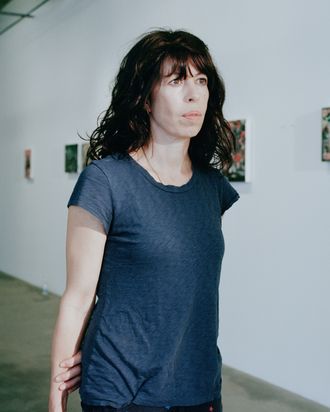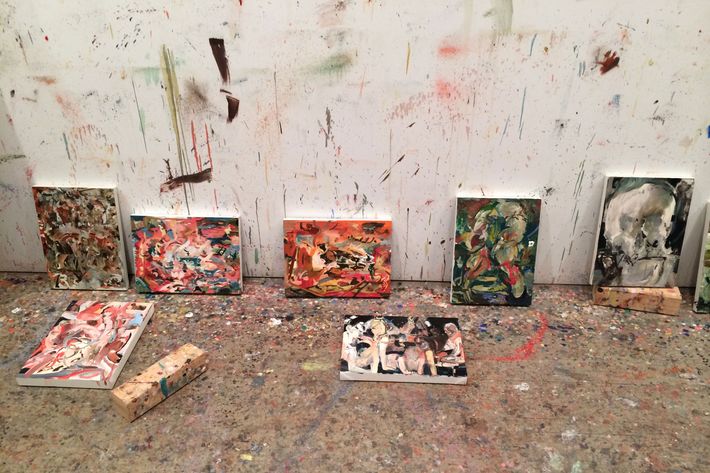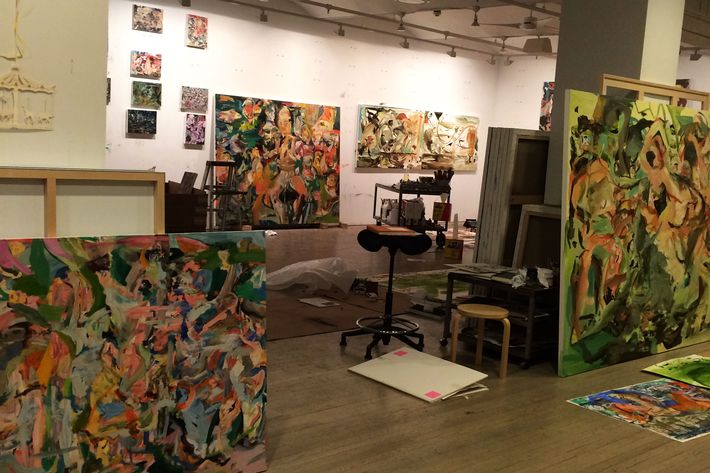
The minute her portrait ÔÇö lying seductively on the floor in front of one of her expressionistic canvases while wearing a T-shirt emblazoned with a dollar sign ÔÇö hit the pages of Vanity Fair in 2000, Cecily Brown became more than an art star. She became a celebrity. The British-born Brown stood out from a cadre of talented young painters who emerged around the new millennium not only for her oversize, erotically charged, and sensually colored paintings but for her equally attention-grabbing, sexy vibe of the naughty girl crashing the boysÔÇÖ club. Larry Gagosian snapped her up when she was just 29, and, as is his M.O., quickly hiked her prices well into the six figures.
Brown recently parted ways with Gagosian, ending a 15-year relationship, much to the curiosity of the art world, which is always obsessed with anybody leaving that powerful, blue-chip gallery. On a spring morning in her loft studio off Union Square, where her sketches share a wall with her 6-year-old daughterÔÇÖs, she is gearing up for a show opening May 9 at Maccarone, a well-regarded West Village gallery located a bit out of the Chelsea hot zone, with a stable of serious artists on the ascent, including Carol Bove and Hanna Liden. The dealer is only one notable change; in place of her typically sprawling canvases, Brown is presenting small abstractions, none more than 17 inches tall or long ÔÇö diminutive enough to hold in your lap.
Brown downplays her departure from Gagosian, going out of her way to gush about Larry. The Maccarone outing, curated by the writer Jim Lewis, may turn out to be a one-off: Brown says sheÔÇÖs in no rush to sign with another gallery. ÔÇ£Being with a gallery is kind of like a marriage, so there doesnÔÇÖt seem to be any reason to leap into another marriage straight away,ÔÇØ she says. ÔÇ£At the same time, itÔÇÖs a lot of work to represent yourself and I certainly donÔÇÖt want to get into selling from my studio.ÔÇØ
In the interim, sheÔÇÖs hired Andrea Crane, an artistÔÇÖs agent and private dealer, to act as a liaison with curators and galleries (though not actually sell BrownÔÇÖs work). Crane has already served as matchmaker with the Drawing Center senior curator Claire Gilman, who is organizing a show of BrownÔÇÖs works on paper for 2017. Brown is thrilled: GagosianÔÇÖs reputation rests on building lucrative markets, not, necessarily, on landing his artists career-defining museum shows. So, in some ways, leaving Gagosian, where she started so young, is a kind of reset for her, and for the way we think about her.
Making the small canvases, many of them evocative of landscapes, provides a welcome respite from the de KooningÔÇôesque grand gestures in her drawings and signature paintings. She sits at a makeshift easel ÔÇö a ladder with a shelf ÔÇö relying more on her hand and wrist, her vision blinkered. ÔÇ£People would see them and say, ÔÇÿAre they studies for the big ones?ÔÇÖÔÇØ she recalls. ÔÇ£That got on my nerves because they werenÔÇÖt. I joked that the big ones had become studies for the small ones. The big ones seemed very fast and loose, and the small ones were very neurotic. There was a while I called them ÔÇÿThe Neurotic Paintings.ÔÇÖ They were so intense, very painterly, the paint got thicker. You have to believe the viewer has a more intimate relationship because you have to get up close.ÔÇØ
At 45, Brown has developed a wry humor. Demonstrating how she draws ÔÇö crouched over a giant sheet of paper on the floor, and sweeping her arm across in graceful arcs ÔÇö she cracks, ÔÇ£ThatÔÇÖs probably why I have this backache.ÔÇØ We commiserate about needing reading glasses. ÔÇ£In a way, IÔÇÖm actually quite enjoying this not seeing my work properly,ÔÇØ she says. ÔÇ£It feeds my work quite well. The fact that I couldnÔÇÖt really make out exactly what I was drawing made the forms much looser. Instead of having a tiger with the details of the stripes and the claws, you got the general impression of the tiger. Not that one wants to hurry along the process, but some of DegasÔÇÖs most beautiful things were when he was going blind.ÔÇØ
Brown talked to SEEN about her feminist reawakening, leaving Gagosian, getting her Instagram fix, motherhood ÔÇö and trying to paint more male nudes.
YouÔÇÖre known for your large, lush canvases. What made you go small?
Most art students will get bigger and bigger and bigger ÔÇö if they can. Space is always a luxury, so the minute you have more, you get a bigger canvas. With each studio I got, I think by then I was on my third New York studio, and each had been a bit bigger than the last; I just naturally went bigger because I could. And also, because the galleries are big. IÔÇÖd always tried, as a way of keeping myself on my toes, to change the proportions. I never just did 48 by 60 [inches]. I decided I should try to do something much smaller. ThereÔÇÖs the old truism: ItÔÇÖs harder to make a small painting than a large one. Obviously, the large ones have a certain impact just because theyÔÇÖre big. ItÔÇÖs very challenging to make something small.

The first small size I got was slightly bigger than this, and I couldnÔÇÖt make a painting on it to save my life. It was just a disaster. There are certain sizes where you feel that nothing fails. These long skinny ones have been driving me mad. TheyÔÇÖre almost impossible to figure out. This one has been working out, but that one over there is just a few inches longer and itÔÇÖs been torture.
This show represents ten yearsÔÇÖ worth of small paintings.
Over the years I made them at different times for different reasons. When I was pregnant I made a lot of them because it became harder to move. The big ones are very physical. Sometimes IÔÇÖll go six months without making any [small ones], but then have this urge and sit down and start. Sometimes IÔÇÖll start ten in the same week, all the same way, like lay down a ground of the same color. There are 50 different directions a painting can go in, which in a way is wonderful because you never feel your work will be done. ItÔÇÖs almost like setting up a game for yourself: What if I start them all with a blue ground, and then one gets red, and the next gets yellow, and one black. How many different ways can I solve this?
These read pretty definitively as abstractions. Did you approach them that way?
No, but I never really do.
So did you begin with some sort of source material?
With the small ones, thereÔÇÖs rarely an outside source. I realized there was a freedom where IÔÇÖd feel I was doing little animal faces and heads and things while I was painting them, which arenÔÇÖt necessarily evident later. Sometimes IÔÇÖd get really into them almost in this hallucinatory way. IÔÇÖd be thinking, HereÔÇÖs the little crowd of evil mice. I could sometimes step back at the end of the day and be like, Where are the evil mice? IÔÇÖd deliberately not get back from them and look, then at the end of the day be like, Whoa! It had become this very dense world, teeming with activity ÔÇö a little like putting your face close to the grass and realizing all the activity. You see how much is going on in one square inch.
I think, in these, I realized more than ever how important it is for me to have a definite figural thought in mind as I work. For me, when it gets purely abstract, it gets decorative. I need to have the sort of weight behind the mark that IÔÇÖm trying to say something specific.

How do you think they compare to your large paintings?
ItÔÇÖs easier to take risks on 19 inches than it is on 19 feet, even though one always tries to keep that risk-taker attitude. I think theyÔÇÖre all part of the same thing and breathe life into one another.
What drives you to work on one or the other?
Sometimes itÔÇÖs just to escape what you were doing before, if you get too bogged down. IÔÇÖve been drawing a lot recently, but for five years or so, I barely did any drawing. I just lost the habit. I actually blame benefits. I hate it when I know what something is for. I donÔÇÖt like it to be for anything. I think I got very self-conscious about drawing for a while. The funny thing is, I havenÔÇÖt shown drawings a lot so I donÔÇÖt think people really know about them. The only way IÔÇÖve showed them is at [benefit] auctions.
Why did you leave Gagosian?
You know, it was 15 years. It was amazing. It was a fantastic experience working with them. I adore Larry. Larry is one of my favorite people. I love him. But after 15 years, it seemed like it would be healthy for my work to be seen in different contexts ÔÇö for me to see my work in other contexts. It just seems exciting to take a ÔÇö what do you call it? ÔÇö throw a curveball. I donÔÇÖt even know baseball, so I donÔÇÖt know if IÔÇÖm even using the term correctly.
You chose to announce your Maccarone show on Instagram. Why are you on Instagram?
ItÔÇÖs a black hole of time-wasting. As a visual addict, I love the silent, constant flow of images. I find it absolutely fascinating that you just go to this little device and have this voyeuristic eye into all of these peopleÔÇÖs worlds, and should you care to, into their friendsÔÇÖ and their friendsÔÇÖ friendsÔÇÖ. You get into these abysses of looking at strangersÔÇÖ pictures. Also, artists you admire. I just started following Mark Grotjahn. He posts all the time. I donÔÇÖt follow so many people who just do their cat or their dinner.
Another painter I know was recently making fun of the way artists post works in progress and their followers all rave about how fab they are.
When I first started, I was private. I knew my followers, so then I might post, half in jest, ÔÇ£Better before?ÔÇØ IÔÇÖd say, ÔÇ£Should I stop?ÔÇØ People would be like, ÔÇ£No, go on.ÔÇØ Others would be like, ÔÇ£Stop!ÔÇØ ItÔÇÖs like when you invite your friends over and youÔÇÖre not sure if something is finished, and you find out whether it is by who you actually want to listen to. I totally know what your friend means. Now IÔÇÖm public, just recently, so I have lots of followers who are young artists, and theyÔÇÖll be like, ÔÇ£Gorgeous!ÔÇØ Yeah, you could just sit there letting your head get bigger because some random person in Australia or Iran says thatÔÇÖs a beautiful painting. But in the end, you canÔÇÖt take it as serious criticism. The image is teeny-tiny. Everything looks good on there. The scary thing is it often looks better. I had my German dealer come over, and she was like, ÔÇ£WhereÔÇÖs that one you posted?ÔÇØ I was pointing at it, and sheÔÇÖs like, ÔÇ£Oh.ÔÇØ But real life is real life ÔÇö you see the history, where the paint didnÔÇÖt dry right. Real life is warts and all. On Instagram, everything is glossy and gorgeous.
Do you still feel that you come more from the male-dominated canon than from feminism?
I used to think when I was younger that one was a born feminist, just because my mum was a feminist and I grew up in the ÔÇÿ70s. I never felt there was anything I couldnÔÇÖt do. But the funny thing is, as timeÔÇÖs gone on, IÔÇÖve realized that things arenÔÇÖt good as I thought and I was really lucky. IÔÇÖm actually very frustrated for women in the art world right now. I feel thereÔÇÖs a major glass ceiling. There are so many fantastic women artists, and they donÔÇÖt do as well as their male counterparts in some areas. ItÔÇÖs crass to talk about the market, but thatÔÇÖs the obvious one. Maybe in another couple of decades, it will be truly equal.
With my own work, of course, I can look at Helen Frankenthaler and Joan Mitchell. There were women who are in the canon. But I come out of a painterly tradition, which tended to be male. When I was younger, I was much more dismissive of that. I didnÔÇÖt notice the gender of the people I was looking at. They just happened to be my favorite painters. [But] when someone says, ÔÇ£Who are your favorite artists?ÔÇØ and you reel off 20 people and then youÔÇÖre like, theyÔÇÖre all white men ÔÇö hopefully if I were an artist in 50 years, that list would be very, very different. Now, having had a kid, I understand there were women artists who just fell off, who probably couldnÔÇÖt afford to be a painter anymore.
But I donÔÇÖt feel bad about the fact that most of my favorite artists are men. I really feel that itÔÇÖs un-gendered. I donÔÇÖt think my female gaze is so different. [But] I get sick now of seeing endless female nudes. I kind of feel like they didnÔÇÖt know any better. That was just the world. IÔÇÖm not going to be mad at Matisse. But IÔÇÖve written on a couple of kidsÔÇÖ Instagrams, ÔÇ£Post more men!ÔÇØ These young figurative painters, the boys and the girls, they post image after image after image of nude females. DonÔÇÖt they provide male models at your schools?
TheyÔÇÖre just numb to it.
You see a nude woman and you donÔÇÖt think twice. You see a nude man, and thereÔÇÖs a beat. IÔÇÖve been trying to paint men. ItÔÇÖs working.
When I first interviewed you, 11 years ago, you were ambivalent about motherhood.
We lucked out; sheÔÇÖs a good kid. Fingers crossed we donÔÇÖt screw her up. She does give me a hard time for working. Of course, I feel incredibly lucky that I have something that absorbs me so much. But my fears were founded: It is really challenging to do both well, to feel that youÔÇÖre doing both well. There is a lot of conflict, and there is a lot of guilt. ItÔÇÖs changed my work life utterly, beyond recognition. But I try not to beat myself up because I feel so many women just spend their time feeling theyÔÇÖre not doing well enough.
When I last saw you professionally, I was working all the hours. I could start late; I could work late; I could work weekends. Suddenly, youÔÇÖre in the world in a way that youÔÇÖre not when youÔÇÖre an artist and donÔÇÖt have a family. YouÔÇÖre forced to be more conventional. School starts at a certain time and finishes. YouÔÇÖre forced to go on vacation when everyone else goes on vacation ÔÇö youÔÇÖre forced to go on vacation! I mean, I was famous among my friends for never taking one. They would tease me about it.
And yes, I do begrudgingly admit that IÔÇÖm probably more focused as everyone said I would be, but I miss being unfocused. I also know itÔÇÖs going to go quickly. In five years, IÔÇÖll be lucky if she wants to hang out with me.
Your husband, Nicolai Ouroussoff, is an architecture critic. Does he have the tendency to turn critic with you?
Um, thatÔÇÖs an interesting question. I think heÔÇÖs quite hands off with me unless I ask. He knows I can get so distracted by an opinion. I am this romantic painter, and I really donÔÇÖt know when something is good. For the most part, itÔÇÖs very up and down ÔÇö today it looks terrific; the next day it looks shit. When things are in the world, IÔÇÖm happy to bring it on. ItÔÇÖs very sensitive in the studio ÔÇö you have to give things plenty of room and the wrong remark, it might even be praise. You find youÔÇÖre not touching that part of the painting because someone said that looked great. Positive criticism is, in a way, the worst.

